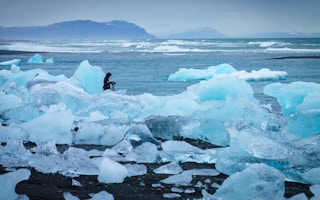Did you shiver in a winter ice storm? Could you wilt in a protracted heatwave this summer? German scientists have just identified the guilty agency and delivered the evidence implicating the jet stream.
Blame it on Arctic warming, they conclude: the retreat of the sea ice over the polar ocean has distorted the pattern of flow of the stratospheric winds usually known as the jet stream.
It is not a new idea. But this time, scientists have employed artificial intelligence and a machine-learning programme to accurately model the changes in the jet stream and then link these to changes in the chemistry of the upper atmosphere, and increasing patterns of twisting waves in the high altitude winds which then distort seasonal weather in the northern hemisphere mid-latitudes. They describe their research in the journal Scientific Reports.
“
Our findings confirm that the more frequently occurring cold phases in winter in the USA, Europe and Asia are by no means a contradiction to global warming; rather they are part of anthropogenic climate change.
Markus Rex, head, atmospheric research, Aldred Wegener Institute
“Our study shows that the changes in the jet stream are at least partly due to the loss of Arctic sea ice. If the ice cover continues to dwindle, we believe that both the frequency and intensity of the extreme weather events previously observed in the middle latitudes will increase,” said Markus Rex, who heads atmospheric research at the Alfred Wegener Institute in Potsdam, Germany.
Cold bouts explained
“In addition, our findings confirm that the more frequently occurring cold phases in winter in the USA, Europe and Asia are by no means a contradiction to global warming; rather they are part of anthropogenic climate change.”
The jet stream – exploited by jet aircraft on the trans-Atlantic routes – is made up of westerly winds that, at an altitude of 10 kilometres, stream around the planet in the mid-latitudes, at speeds of up to 500 km an hour, and push weather systems from west to east.
But researchers have already observed this: they have been changing, in response to global warming and in particular to the rapid warming of the Arctic, as greenhouse gas ratios in the atmosphere rise, and go on rising, in response to profligate human combustion of fossil fuels.
Rather than stick to a course more or less parallel to the Equator, these winds have been observed describing dramatic waves.
These twists of direction have been linked to blasts of Arctic air into regions that could normally expect relatively mild winters: in particular to the ferocious cold that hit the US Midwest in January 2019.
These winds have also weakened and been linked to prolonged drought and extremes of heat that hit Europe in 2003, 2006, 2015 and 2018.
But association is not the same as demonstration of cause-and-effect. The Potsdam scientists wanted surer evidence. And their new climate simulations now include a machine-learning component that accounts for ozone chemistry at high altitudes.
And what their new model found was that as the Arctic sea ice retreats, the atmospheric waves have warmed the polar stratosphere in ways that have been amplified by the behaviour of the ozone layer.
Ozone response
Since what powers the jet stream is the difference between the cold Arctic and the warm tropics, the jet stream has weakened, and begun to meander, like a river flowing across a flood plain towards the sea.
In effect, the new study introduces a new piece to the climate puzzle: the response of the ozone layer and its role in the play of winds around the planet. The pay-off could be a clearer picture of things to come.
“We are now for the first time employing artificial intelligence in climate modelling, helping us arrive at more realistic model systems,” said Professor Rex.
“This holds tremendous potential for future climate models, which we believe will deliver more reliable climate projections and therefore a more robust basis for political decision-making.”
This story was published with permission from Climate News Network.








